

Steves Computer Vision Blog: Playing YouTube videos in the browser on the Raspberry Pi. This will allow you to stream up to 1080p youtube videos in the browser on the Raspberry pi using omxplayer.
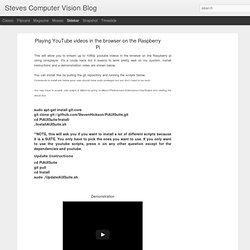
It's a crude hack but it seems to work pretty well on my system. Install instructions and a demonstration video are shown below.You can install this by pulling the git repository and running the scripts below.Commands to install are below (your user should have sudo privileges but you don't need to be root):You may have to enable user scripts in Midori by going to Menu>Preferences>Extensions>UserScripts and clicking the check box. sudo apt-get install git-core git clone cd PiAUISuite/Install/. cd PiAUISuite git pull cd Install.
Steves Computer Vision Blog: Playing YouTube videos in the browser on the Raspberry Pi. DragonTail Mapping and the Raspberry Pi. Ultrasonic Distance Measurement Using Python – Part 1. LEDs, buzzers and switches are the most common items people attempt to interface to their Raspberry Pi’s.

Something I found in eBay that is a little bit different is an ultrasonic measurement module. This allows you to measure the distance to the nearest wall or solid object. The modules are easy to buy, cheap and relatively straight forward to interface to the GPIO header. So here is some information on my experiments with an Ultrasonic measurement module and Python.
Infrared Proximity Sensor - Sharp GP2Y0A21YK. Proximity Detection. The Explorer PCB has an infrared proximity sensor at each of it's four corners.
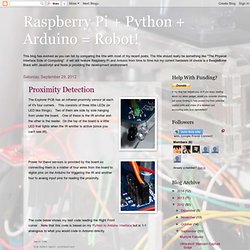
This consists of three little LEDs (or LED like things). Two of them are side by side hanging from under the board. One of these is the IR emitter and the other is the reader. On the top of the board is a little LED that lights when the IR emitter is active (since you can't see IR). Distance sensor data gathering. So I was able to start gathering sensor data last night.
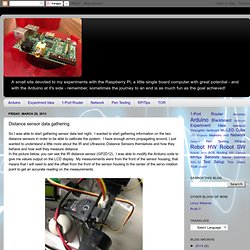
Maxbotix Ultrasonic Rangefinder - LV-EZ3 [LV-EZ3] ID: 981 - $24.95. Proximity. Halloween Pumpkin. Pololu Sharp GP2Y0D810Z0F Digital Distance Sensor 10cm Breakout. This small digital distance sensor detects objects between 2 and 10 cm (0.8" and 4") away.
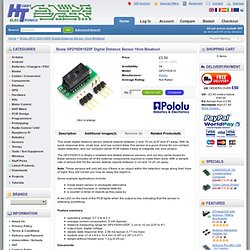
With its quick response time, small size, and low current draw, this sensor is a good choice for non-contact object detection, and our compact carrier PCB makes it easy to integrate into your project. The GP2Y0D810 is Sharp’s smallest and fastest distance sensors, and our tiny carrier board for these sensors includes all of the external components required to make them work. With a sample rate of almost 400 Hz the sensor detects objects between 2 cm and 10.25 cm away. Note: These sensors will only tell you if there is an object within the detection range along their lines of sight; they will not tell you how far away the object is. Some example applications include: break-beam sensor or photogate alternative non-contact bumper or obstacle detector a counter or timer of objects as they pass by Documents GP2Y0D810Z0F Datasheet There are no reviews for this product. Write Review. Buy Photoelectric Sensors Distance Sensor 10cm Digit.,GP2Y0D810Z0F Sharp GP2Y0D810Z0F online from RS for next day delivery.
DC 5V IR Sensor Obstacle Avoidance Sensor Robot Switch. Kinect SDK C++ Tutorials - 2. Depth Images. Goals: Learn how to get depth data from a kinect and what the format of the data is.
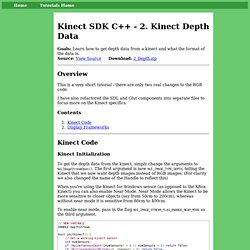
Source: View Source Download: 2_Depth.zip Overview This is a very short tutorial - there are only two real changes to the RGB code. I have also refactored the SDL and Glut components into separate files to focus more on the Kinect specifics. Contents Kinect Code Kinect Initialization. A Laser Range Finder using RapsberryPi, Arduino and OpenCV. I've been working on a project to build a Laser Range Finder using a Raspberry Pi , an Arduino and OpenCV using a webcam. I hope that eventually this project may be used on a mobile robot using the algorithms taught on Udacity CS373 specially SLAM (Synchronous Location and Mapping).
The First Prototype This first protoype is more a proof of concept than a usable device. Anyway, it's working pretty well except for it being quite slow. Raspberry Pi Model B running: Archlinux ARM with a modified kernel to support the Arduino and the Webcam OpenCV 2.4.1 Python 2.7 The LRF software Arduino UNO connected via USB to the Raspberry Pi. Also check the video for an overview on it's parts and how it works. This prototype is very slow (one measurement takes about 10 seconds) but I'm optimistic that it may become more functional on a couple of iterations, specially with the upcoming Raspberry Pi Foundation CSI camera. All comments are welcome here (comments section at the bottom) or via Twitter . Raspberry PI / Arduino... Raspberry Pi distance measuring sensor with LCD output. IR distance sensor includes cable (10cm-80cm) [GP2Y0A21YK0F] ID: 164 - $14.95.
Ultra cheap ultrasonics, and a bit of a challenge. Joan wrote:Excellent.I think the physics of sound waves rather limits the update rate of acoustic sensors.

If you had some more they'd probably interfere with each other. I think you'd have one transmitter and the rest would be passive listeners.Given what you have achieved do you now think it possible to extend the idea to motor/LED PWM? Heh, I take your point about the physics, but if I point the thing at a table 10cm away and get an echo in 0.5ms, it seems a shame that I apparently have to wait 59.5ms before I can trigger it again. I'll experiment, maybe I can get away with it in a specific environment like that, or maybe the first pulse will have bounced off the desk and be echoing back off the ceiling and interfering with the second measurement. As they apparently only detect things within a 15 degree angle I had ideas of a few mounted at different angles round a buggy but again I suppose echoes round the room might mean they interfere with each other.